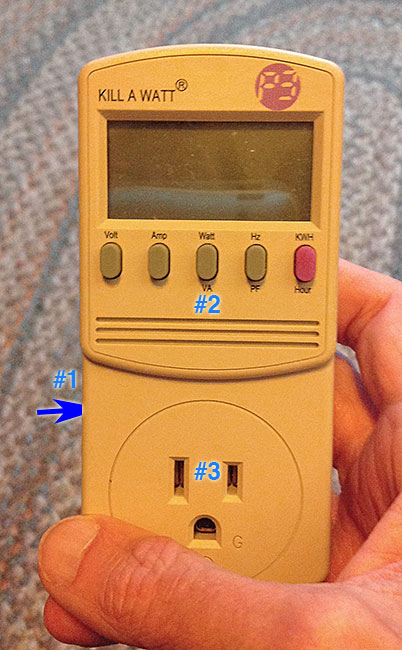Measuring your electric consumption
 In this assignment, you'll measure and estimate how you use electricity.
You'll estimate how much electricity you use for a variety of appliances.
In this assignment, you'll measure and estimate how you use electricity.
You'll estimate how much electricity you use for a variety of appliances.
As a class, we'll use your results to try to get a handle on where we use the most, and what we might target *first* for conservation efforts.
Your report
I've randomly assigned each of you to a group (below).
Each person should use a Kill-a-Watt meter to make measurements on one electricity-consuming device. Enough measurements to estimate how much energy you use on a weekly basis for that device.
Collaborate as group in writing up one report per group. One person in your group should hand in the report on Moodle, with all the partners' names in it.
Your report should include
- Your estimates for your weekly energy use from the same number of common devices as the number of people in your group.
- For each "device" you examined, write 1 or 2 paragraphs showing your measurements, calculations and results, and
describing your assumptions and estimates.
For example, you may have measured the power consumption of your TV, and then multiplied that by your estimate of how many hours / week of TV that you watch.
- Together, write about 2 paragraphs of reflection on what you've measured and calculated. What used more or less energy? What were you uncertain about? What room is there for further energy conservation here? Was there anything that surprised you? What are you curious about: Are there further questions that this assignment sparked for you?
Kill-a-Watt
The library has these handy "Kill-a-Watt" meters that you can check out (for up to a week).

The *very short* instructions are:
- Plug the meter into the wall (#1).
- Plug some appliance into the socket on the front (#3)
- Press the "Watt" key (#2) to see the instantaneous power consumption (in Watts) of whatever you've plugged in.
For small devices
You can measure the instantaneous power and then estimate how many hours you use it. For example:
I measured the energy that my led light strip uses. I plugged it in to the Kill-A-Watt meter and observed the instantaneous power as 6.9 watts. So, I use the led lights for about 2 hours every day 7 days a week, which is about 14 hours a week. If we multiply 6.9 Watts by 14 hours we get 96.6 Watt*hours. To find out the kilo-watt*hours (kWh) we divide 96.6 by 1000 and then we'll get 0.0966 kWh [energy used in one week].
For bigger appliances
You can measure the total power that appliance uses in a set period of time, as it turns off and on.
- Press the pink "KWH / Hour" button once: You'll see the *total energy* (in kW$\cdot$hrs) used by *anything* that you've plugged into the meter since you plugged the meter in.
- Press the pink button a second time: You'll see the total time the meter has been plugged in in hours:minutes format.
Here's a sample description that documents how energy was measure, and the total energy....
I monitored my mini-fridge for this assignment. It’s a small, relatively simple fridge with no freezer, and about 10 cubic feet of space. I measured it with the Kill-A-Watt over the course of 8 hours, from 11 a.m. to 7 p.m. I then used the pink kWh button to find the total energy consumed over 8 hours, which was 0.12 kilowatt hours (kWh). Since I have the minifridge running all the time, I multiplied this number by 3 (8 hours is 1/3 of a 24-hour day) to get 0.36 kWh energy used per day.
Some documentation on using these meters:
- basic instructions for using the Kill A Watt meter (
- The PennState instructions have clearer pictures and info about which button does what.
As a group
You'll submit one report per group, documenting your estimate of energy use (kWh) per week for the same number of appliances/devices as there are people in your group. You'll base your estimates on measurements that you make with the Kill-A-Watt meter.
Groups
Calculations
$$E=P*t$$ Energy (in kWh) = power in kilowatts multiply by time in use in hours.For smaller appliances, you'll measure the instantaneous power used by the device, and estimate the number of hours you use such a device in a week.
For larger appliances, you can use the pink button on the Kill-A-Watt meter to see the total energy in kWh used since you plugged the meter in, and the time during which it was used. Scale this up to a week's use.
For phones and computers: You'll use the "small appliance" advice above. You might want to measure the total energy for one charge by running the device down, charging, and noting the average power during charging, and the total time it took to charge. Then estimate how many times you have to do a *full charge* in a week.
This is a bit different from how most people use their laptops, where you have it plugged in and charging while you use it, and so it may be charging up during part of the time and "topping up" (at lower power) during part of the time.